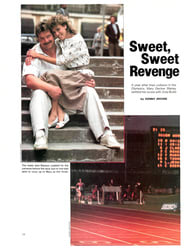
LETTER FROM THE PUBLISHER
One look at the paintings that accompany the story on Bobby Fischer in this issue (page 70), and you might think that artist Greg Spalenka works in a dank dungeon and resembles Heathcliffe or Igor. But, no, Spalenka's studio in New York City's Greenwich Village is bright, modern and spotless, and Spalenka, who is 27 and looks 17, is just as sunny and cheerful.
Spalenka smiles a lot, offers visitors a choice of fruit juices and makes his childhood in Mission Viejo, Calif. sound singularly untroubled. There were, he says, "three boys and three girls, and the oldest was named Greg. Just like the Brady Bunch." All of which contrasts vividly with the cerebral, intense images he creates. He shrugs and acknowledges, "People often call my work moody."
The Fischer assignment was a challenge for Spalenka. While many illustrators work from photographs and their own ideas about a subject, Spalenka prefers to meet the people he portrays. "I work like a reporter," he says. "I do something called a visual interview. I pick up different aspects and characteristics—the way a person moves and stands and the voice—and try to incorporate that into the portrait. It's very intuitive." He often takes Polaroid shots for visual notes, then works while his impressions are still fresh.
The reclusive Fischer, however, wasn't even available for Polaroid shots. Spalenka sent copies of his work and a letter to Claudia Mokarow, Fischer's confidante, asking to see the former world chess champion, but there was no response. "If I had seen him, I would have liked to do small sketches of his hands, his shoes—parts of him that reveal character," Spalenka says.
Indeed, Spalenka had to work with old photographs of Fischer. But he also flew to California to interview erstwhile Fischer acquaintances Ron Gross and Lina Grumette and to visit places associated with Fischer. "I was trying to create a sense of mystery to suit the story—an ambiguous realism," he says.
Just three years after graduating from the Art Center College of Design in Pasadena, Spalenka finds himself in great demand as a portraitist and illustrator. His work includes a remarkable series of portraits of fellow New York illustrators that appeared recently in Print, a publication for graphic artists. "I like doing people—anatomical structures," he says.
Has Spalenka done any portraits of members of his family? "Well, not really," he says. "I did my grandma, but she doesn't like it. I have to do it over."
PHOTO
NANCY MORAN/SYGMA
SPALENKA STROVE FOR A SENSE OF MYSTERY

